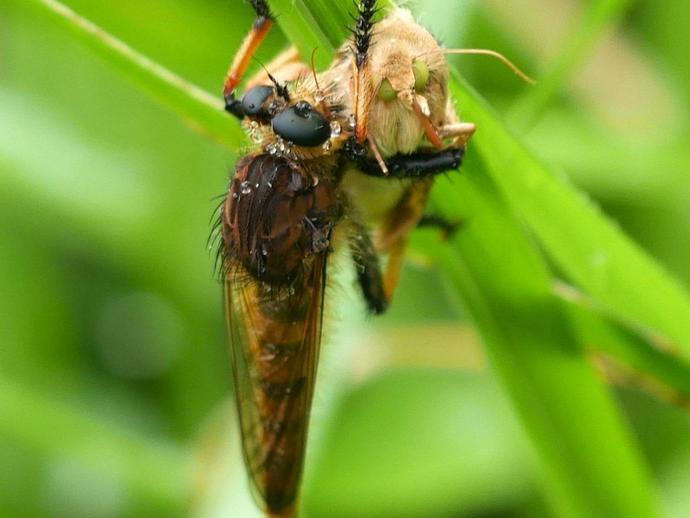August 19, 2020
Promachus rufipes, also known as the red-footed cannibalfly or bee panther, is one fierce little predator. If you don't believe me, just ask the unfortunate moth that this one captured!
The red-footed cannibalfly belongs to the family Asilidae, members of which are commonly called "robber flies." Robber flies are voracious ambush predators; during the warmest hours of the day, they take a strategic position in an open sunny area where they watch and wait. Once they see an enticing-looking insect fly by, they take off and catch it in mid-air! Once they've caught something, they use their short, powerful proboscis to inject it with neurotoxic enzymes that paralyze the prey and digest its insides, which they then suck up through the proboscis (by the way, I hope you weren't eating lunch when you read that).
Just how good are robber flies at catching prey in mid-air? While it doesn't happen often, I found a report of this exact species of robber fly unsuccessfully attempting to take down a ruby-throated hummingbird, and another account of a larger species of robber fly (Mallophora leschenaulti) successfully taking down a hummingbird!
While all of that may sound, you know, terrifying, we really don't have anything to fear from robber flies. Unlike horse flies, which need to feed on blood before they can lay their eggs, robber flies don't eat blood so they have no reason to bite humans. You might get bitten if you handle one roughly, though, so if you see one, just leave it be.
Robber flies are actually a very beneficial insect to have in your garden since they commonly eat pest insects, including everyone's least favorite, the brown marmorated stink bug (Halyomorpha halys). For that service alone, someone ought to put the robber fly on a stamp. #BenInNature
ABOUT THIS POST
Social distancing can be difficult, but it presents a great opportunity to become reacquainted with nature. While he is working from home, Administrator of Science Ben Williams is venturing outdoors each day to record a snapshot of the unique sights that can be found in the natural world.
NATURE PHOTO IDENTIFICATIONS
If you discover something in nature that you would like help identifying, be sure to message us right here on Facebook with a picture (please include location and date of picture) and we'll have our experts help you identify it!

 Hours & Admissions
Hours & Admissions Directions
Directions

